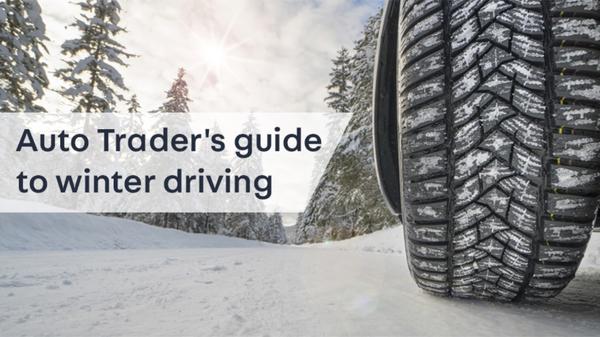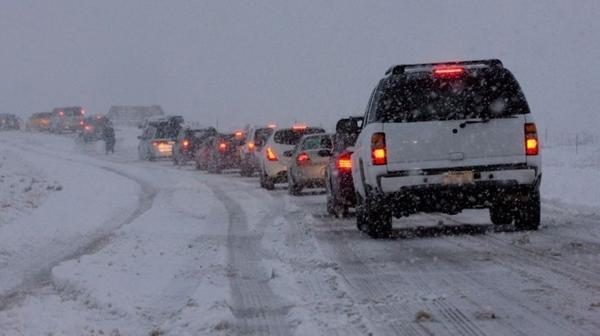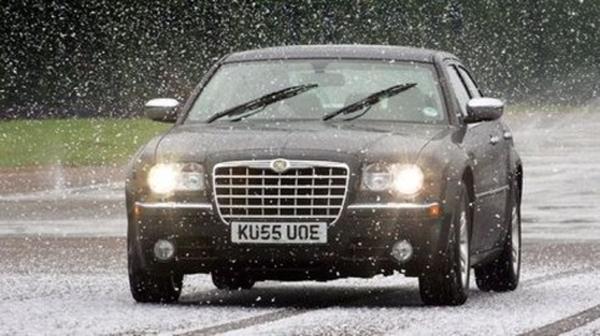Guide
How to drive in snow safely 2025
Read our advice on how to drive in snow and icy conditions, and tackle snow-covered roads like a pro.


Words by: Andrew Woodhouse

Additional words by: Nimisha Jain
Last updated on 1 November 2024 | 0 min read
Driving in snow and icy conditions can be scary especially if you're driving in winters for the first time. Slippery roads and poor visibility can also make many people anxious to get behind the wheel, but don’t worry – here’s our advice to help you stay safe and sound this winter.
Remember, it may be best to avoid or delay driving in wintery conditions if your journey isn't absolutely necessary. How to drive in snow Dangers of driving in snow How to overcome winter driving anxiety
Remember, it may be best to avoid or delay driving in wintery conditions if your journey isn't absolutely necessary. How to drive in snow Dangers of driving in snow How to overcome winter driving anxiety
How to drive in snow
Before moving off
According to the Highway Code, before you set off, you must clear off any snow and ice from the windows and de-mist the mirrors so that you can clearly see ahead. You're also required to have your lights and number plates visible at all times.
Make sure to clear off the snow from the path so that it doesn't get in your or other drivers' way. You should also check the weather prediction ahead of your trip to avoid driving when it's severe weather.
Make sure to clear off the snow from the path so that it doesn't get in your or other drivers' way. You should also check the weather prediction ahead of your trip to avoid driving when it's severe weather.
Speed and stopping distance
The most basic rule for driving in snow is to drive slowly and with enough space between you and the car in front of you.
Driving fast can cause wheelspin and make your car lose traction. When driving in snow, you should leave a stopping distance that is at least 10 times greater than in normal weather conditions. This should give you ample reaction time if you need to brake.
Driving fast can cause wheelspin and make your car lose traction. When driving in snow, you should leave a stopping distance that is at least 10 times greater than in normal weather conditions. This should give you ample reaction time if you need to brake.
Braking
It’s best to avoid braking where possible, as normal tyres have a lower grip on icy roads. The best way to decelerate is by changing gears.
You may press the brakes gently to indicate that you’re slowing down to the vehicle behind you.
You may press the brakes gently to indicate that you’re slowing down to the vehicle behind you.
Headlights
You should use dipped headlights when driving in heavy snow, as they help when visibility is poor without dazzling other drivers. They also make your car visible to other road users behind you.
Fog lights should be used when visibility becomes less than 100 metres in front of you.
Fog lights should be used when visibility becomes less than 100 metres in front of you.
Driving uphill and downhill
If you’re approaching a slope, leave an ample gap between you and the vehicle ahead or wait until the car in front has passed by so that you don’t need to stop midway.
When driving uphill, leave plenty of room between yourself and the vehicle in front so you don’t have to stop midway. Keep a steady speed and try not to change gear. Similarly, when driving downhill you should leave plenty of room. Drive slowly to avoid braking where possible and use a low gear.
When driving uphill, leave plenty of room between yourself and the vehicle in front so you don’t have to stop midway. Keep a steady speed and try not to change gear. Similarly, when driving downhill you should leave plenty of room. Drive slowly to avoid braking where possible and use a low gear.
Driving through a bend
On a bend, you should apply the brakes gently before you start turning the steering wheel to avoid losing traction.
Make sure that the wheels point to where you want to turn and that you’re not accelerating while turning.
Make sure that the wheels point to where you want to turn and that you’re not accelerating while turning.
Controlling a skid
If your car starts skidding on icy roads, do not take your hands off the steering wheel. Steer your car in the direction of the skid to correct it.
Do not brake your car as it may start spinning completely – unless you think you’re going to crash into something, in which case you should brake gently. Winter tyres are specifically designed to perform better in icy and snowy conditions, giving you increased grip during cornering and braking. Check out our guide on winter tyres to find out whether they could help keep you safe on our roads this winter.
Do not brake your car as it may start spinning completely – unless you think you’re going to crash into something, in which case you should brake gently. Winter tyres are specifically designed to perform better in icy and snowy conditions, giving you increased grip during cornering and braking. Check out our guide on winter tyres to find out whether they could help keep you safe on our roads this winter.
Five dangers of driving in snow
Even the most experienced drivers can find themselves in a dangerous situation when driving in winter. Find out more about the dangers of driving in icy weather and what to do if you find yourself in such a situation to stay safe.
1. Slippery roads
Snow and ice mean the risk of losing grip and skidding is much higher than normal.
You can reduce this by making sure all your inputs into the car (the brakes, the steering and the accelerator) are as gentle as possible. If you start skidding, pull away in second gear and avoid wheel-spin by gently easing-off the clutch. If you drive an automatic car, then check your handbook for specific advice. Some automatics have a ‘winter’ mode.
You can reduce this by making sure all your inputs into the car (the brakes, the steering and the accelerator) are as gentle as possible. If you start skidding, pull away in second gear and avoid wheel-spin by gently easing-off the clutch. If you drive an automatic car, then check your handbook for specific advice. Some automatics have a ‘winter’ mode.
2. Poor visibility
It’s difficult to see the vehicles and pedestrians around you when driving in winter because of factors like longer dark nights, dense fog or heavy snow rainfall.
Use your headlights in reduced visibility. You can use fog lights if visibility is reduced to 100m, just make sure you switch them off again when visibility improves. Make sure all your lights are working and that the lenses are clean. Lights may get splashed with snow and slush when driving so ensure they’re clean before you set off. Similarly, make sure your number plates are clean (you may get fined if they aren’t). Related: Xenon and LED car lights explained.
Use your headlights in reduced visibility. You can use fog lights if visibility is reduced to 100m, just make sure you switch them off again when visibility improves. Make sure all your lights are working and that the lenses are clean. Lights may get splashed with snow and slush when driving so ensure they’re clean before you set off. Similarly, make sure your number plates are clean (you may get fined if they aren’t). Related: Xenon and LED car lights explained.
3. Car breakdowns because of damaged batteries in winters
The cold weather affects your car’s battery and reduces its life significantly. The cold weather slows down the battery’s performance which is why it takes more time for it to charge fully. Winters will affect your car’s battery even more if it’s old and weak.
If your engine doesn’t start, wait at least 30 seconds between attempts and turn off electric-dependent features like lights, window heaters and wipers. If you’re having no luck, it may need charging. With batteries, prevention is better than a cure – just keep your battery topped up. A short journey will allow the battery to recharge itself effectively. If you don’t use your car very often, a regular overnight trickle charge will help maintain battery health. When your car isn’t in use, consider keeping it in a garage or under a cover — which can help prevent fluids freezing, protect the car from salt being spread nearby, and save you time in the mornings by removing the need to de-ice. Related: How to jump start a car.
If your engine doesn’t start, wait at least 30 seconds between attempts and turn off electric-dependent features like lights, window heaters and wipers. If you’re having no luck, it may need charging. With batteries, prevention is better than a cure – just keep your battery topped up. A short journey will allow the battery to recharge itself effectively. If you don’t use your car very often, a regular overnight trickle charge will help maintain battery health. When your car isn’t in use, consider keeping it in a garage or under a cover — which can help prevent fluids freezing, protect the car from salt being spread nearby, and save you time in the mornings by removing the need to de-ice. Related: How to jump start a car.
4. Frozen engines
The snow or icy weather sometimes freezes the radiator which can cause your car to overheat or make unusual noises.
Should this be the case, you should pull over as soon as it’s safe to avoid causing serious damage. If you hear a prolonged squealing sound, the water pump could be frozen and will need to thaw out — again you should stop as soon as it’s safe to prevent serious damage.
Should this be the case, you should pull over as soon as it’s safe to avoid causing serious damage. If you hear a prolonged squealing sound, the water pump could be frozen and will need to thaw out — again you should stop as soon as it’s safe to prevent serious damage.
5. Running out of fuel
When driving in winters, you’re likely to find yourself amidst congestion and delays on the road. This is because snow and icy conditions make the roads challenging to drive on, thus slowing down vehicles.
Besides the longer journeys, winter essentials like winter tyres, heater and window defroster also use more fuel which makes you more vulnerable to running out of fuel. That’s why you should ensure that you have enough fuel in the tank to last what could be a long and stressful journey. You should avoid idling or ‘warming up’ your car before heading out as it uses a lot of fuel and damages the engine. If your car is due a service, consider getting it done before winter weather sets in properly — and ask if your garage offers winter-specific services. This will help in ensuring that you get the best mileage on your car and that it’s running on its peak efficiency.
Besides the longer journeys, winter essentials like winter tyres, heater and window defroster also use more fuel which makes you more vulnerable to running out of fuel. That’s why you should ensure that you have enough fuel in the tank to last what could be a long and stressful journey. You should avoid idling or ‘warming up’ your car before heading out as it uses a lot of fuel and damages the engine. If your car is due a service, consider getting it done before winter weather sets in properly — and ask if your garage offers winter-specific services. This will help in ensuring that you get the best mileage on your car and that it’s running on its peak efficiency.

Reduce anxiety when driving in snow and winter driving
Dark gloomy days, chilly weather, slippery roads and heavy traffic – all these factors are enough to make you feel anxious when driving in winter. But you can tackle your fears with the help of some tips to make you feel more confident on the road in winter.
1. Pack your winter kit
The winter emergency kit includes everything that you might need in case your car breaks down or gets stuck in snow, from an ice scraper to warning triangle, first aid kit, shovel and so on.
Make sure that you carefully pack all the essential items in your kit and that you refresh the items from time to time, to replace any old, broken or used item. Knowing that you have a fully stocked winter emergency kit with you will help give you peace of mind when driving in winter.
Make sure that you carefully pack all the essential items in your kit and that you refresh the items from time to time, to replace any old, broken or used item. Knowing that you have a fully stocked winter emergency kit with you will help give you peace of mind when driving in winter.
2. Check and recheck
Before you head out for your journey, check twice that your car is prepared for the icy roads.
Make sure that car has enough fuel, the tyres are fitted with snow chains if you’re driving in snow, the headlights are clean and working properly, your antifreeze is topped up, you’ve kept your winter emergency kit in the car and so on. This will help you in leaving the house feeling confident and ready to drive in winter. Related: Winter checklist: car preparation essentials
Make sure that car has enough fuel, the tyres are fitted with snow chains if you’re driving in snow, the headlights are clean and working properly, your antifreeze is topped up, you’ve kept your winter emergency kit in the car and so on. This will help you in leaving the house feeling confident and ready to drive in winter. Related: Winter checklist: car preparation essentials
3. Remain calm
Driving in winter can mean longer journeys than usual because of the congestion.
Once you’re on the road, try and remain calm. Make sure that you’re taking all the precautions for staying safe like maintaining a good stop distance, using your headlights and indicator, and driving slowly so that you feel safe when driving. Listen to soothing music to keep yourself from worrying or talk to other passengers in the car, if any, but make sure that you don’t get distracted.
Once you’re on the road, try and remain calm. Make sure that you’re taking all the precautions for staying safe like maintaining a good stop distance, using your headlights and indicator, and driving slowly so that you feel safe when driving. Listen to soothing music to keep yourself from worrying or talk to other passengers in the car, if any, but make sure that you don’t get distracted.
4. Prepare for the worst
The number of car accidents and breakdowns increase in winters because of the snow and slippery roads. Thus, it’s important to know what to do if you find yourself in such a situation.
Having a winter kit with you isn’t enough. You should also learn how to use these items properly to get your car back on the road. Be prepared by learning things like changing a flat tyre, jump-starting a car, putting on snow chains and so.
Having a winter kit with you isn’t enough. You should also learn how to use these items properly to get your car back on the road. Be prepared by learning things like changing a flat tyre, jump-starting a car, putting on snow chains and so.
5. Get a Pass Plus certification
You could also consider getting help from a professional to learn how to drive in snow and icy conditions by getting a Pass Plus certification.
This six-hour training prepares you for driving in different situations including bad weather conditions. This can help you in feeling more confident, not just when you’re when driving in winter, but also to tackle other challenging roads such as motorways and driving at night.
This six-hour training prepares you for driving in different situations including bad weather conditions. This can help you in feeling more confident, not just when you’re when driving in winter, but also to tackle other challenging roads such as motorways and driving at night.

Learn more about tips on driving in icy conditions or check our top cars for driving in snow.